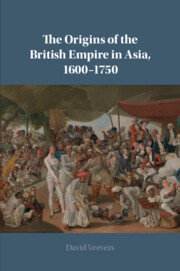Book contents
- The Origins of the British Empire in Asia, 1600–1750
- The Origins of the British Empire in Asia, 1600–1750
- Copyright page
- Dedication
- Contents
- Maps
- Acknowledgements
- Maps
- Introduction
- Part I Weakness and Adaptation
- Part II Subordination and Expansion
- 4 ‘To Be Determined by the Moor’s Justice’
- 5 ‘A Firm Settlement in This Place’
- Part III Limitations and Devastation
- Part IV Empire
- Conclusion
- Bibliography
- Index
5 - ‘A Firm Settlement in This Place’
War, Negotiation and Imperial Integration
from Part II - Subordination and Expansion
Published online by Cambridge University Press: 20 May 2020
- The Origins of the British Empire in Asia, 1600–1750
- The Origins of the British Empire in Asia, 1600–1750
- Copyright page
- Dedication
- Contents
- Maps
- Acknowledgements
- Maps
- Introduction
- Part I Weakness and Adaptation
- Part II Subordination and Expansion
- 4 ‘To Be Determined by the Moor’s Justice’
- 5 ‘A Firm Settlement in This Place’
- Part III Limitations and Devastation
- Part IV Empire
- Conclusion
- Bibliography
- Index
Summary
The Anglo-Mughal War of 1686–1690 is the focus of Chapter 5, which seeks to challenge traditional understandings of the war as the result of a more capable and belligerent Company seeking to impose its will on the Mughal empire and expand its territory and rights by force, culminating in the acquisition of Calcutta. Instead, this chapter places the war within the context of the personal tensions and conflicts produced by the transcultural ties which bound Company servants and Mughal elites together. Some servants sought to renegotiate these increasingly one-sided relationships with a limited show of force, for which they were immediately expelled from Bengal by the Mughal government. Only after ten years of complex negotiations, in which new transcultural relationships were established with an entirely new Mughal regime, could the Company return and develop Calcutta as a settlement. Even then, its expansion relied on the Company’s utility to the new Mughal regime, to which they contributed men and money to uphold the nawab’s authority against several large-scale rebellions. By the turn of the eighteenth century, the Company transformed itself into a key client of the Mughal government which could be mobilised to consolidate the empire’s control of Bengal in exchange for greater rights and privileges.
Keywords
- Type
- Chapter
- Information
- The Origins of the British Empire in Asia, 1600–1750 , pp. 135 - 174Publisher: Cambridge University PressPrint publication year: 2020

